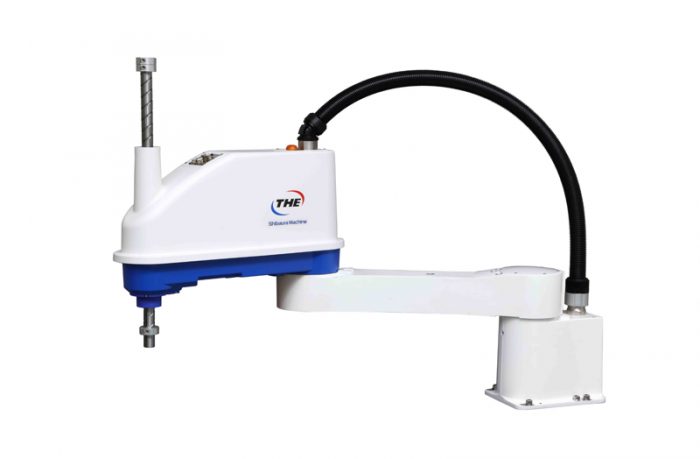Shibaura Machine’s new THE800 and THE1000 robots fulfill precision requirements of EV battery assembly

Production of electric vehicles (EVs) doubled to a record 6.6 million vehicles in 2021 — a stark contrast to the otherwise depressed automotive market, which declined to just under 70 million units in 2021, from a peak of 80 million in 2017. Here, the role of robotics in the rapidly changing automotive production market is examined.
The growth of the EV sector marks a dramatic shift from the traditionally fuel-intensive automotive market, but there are several new challenges to face. One lies in the material-intensive nature of battery production. The global scarcity in key raw materials like lithium, needed to make battery cells, means that EVs are still colossally expensive to produce. However, this doesn’t seem to be slowing down demand.
In fact, sales of EVs are dramatically surpassing industry forecasts for the market every single year in China, Europe and even in the previously EV-cautious US market. Considering the state of the diesel and petrol vehicle market; vilified by soaring fuel costs, more environmentally-conscious consumers and looming regulations for the eventual redundancy of petrol and diesel cars, it is no surprise that EVs are gaining momentum.
Vehicle manufacturers must prepare mass manufacture of EVs, and this includes changes to hardware and robotics. As early as the 1960s, the automotive industry has used robotics in assembly, welding and parts handling processes. In fact, General Motors was the first ever company to use industrial robots with the deployment of Unimate, a six-axis robot used to automate diecasting in 1962.
Today, almost every aspect of vehicle production uses some kind of automation. But, how does this change with EV manufacturing?
Battery assembly is a core application for robotics in EV production. The heavy-lifting required for assembling batteries simply cannot be done without machine-power. What’s more, since EV battery size reflects the range in which the vehicle can travel, consumers are increasingly demanding higher ranges — and thus larger batteries and battery parts — requiring robots with increasingly heavy payloads.
Shibaura Machine has developed an evolution of its THE SCARA robot range for this specific application. The THE800 and THE1000 models are an ideal choice for tasks involving heavier components of up to 20kg that still require a high level of precision. The robots boast a cycle time of just 0.4 seconds with a 2kg load, with an impressive 8,400mm per second and 9,500 mm per second joint speed respectively. To maintain accuracy during the precise process of EV battery assembly, a robot of this quality is key.
The Shibaura Machine THE SCARA range can be used in cell and module production for secondary EV batteries. This includes the production of pouch, cylindrical and prismatic type battery cells. The most common, the pouch cell, of which there are up to 12 in each battery module, weights from 800g to 1kg and thus requires the payload and high cycle times delivered by this robot range.
Another challenge of EV production is the race to bring new models to market. Naturally, it takes time to deploy new technologies, establish supply chain and develop new vehicle concepts — particularly in currently dominated by a few estimated EV players, like BYD and Tesla. Moreover, the scarce supply of EV batteries and the robots to assemble them has the potential to create more delays for manufacturers who do not prepare well in advance.
For manufacturers hoping to gain EV market share, establishing a supply network for batteries and robots is essential. With the sale of diesel and petrol-powered vehicles on a continuous decline, and the EV market continuing to surpass forecasts, it is crucial for manufacturers to stay ahead of the curve with their supply chains and technologies.
While robots have played an essential part in automotive production for more than half a century, their role in assembling batteries will be key for the EV sector to continue to thrive.
For more information, please visit http://www.tmrobotics.co.uk.
News Categories
- » NEWS HOME
- » Automation & Robotics
- » Industry 4.0
- » Material Handling
- » Sensors
- » Quality & Testing
- » Machine Vision
- » Laser & Optics
- » Metalworking
- » Motion Control & Drives
- » Hydraulics & Pneumatics
- » Process Industry
- » Renewable Energy
- » Agriculture
- » Home & Office Furniture
- » Environmental Tech




